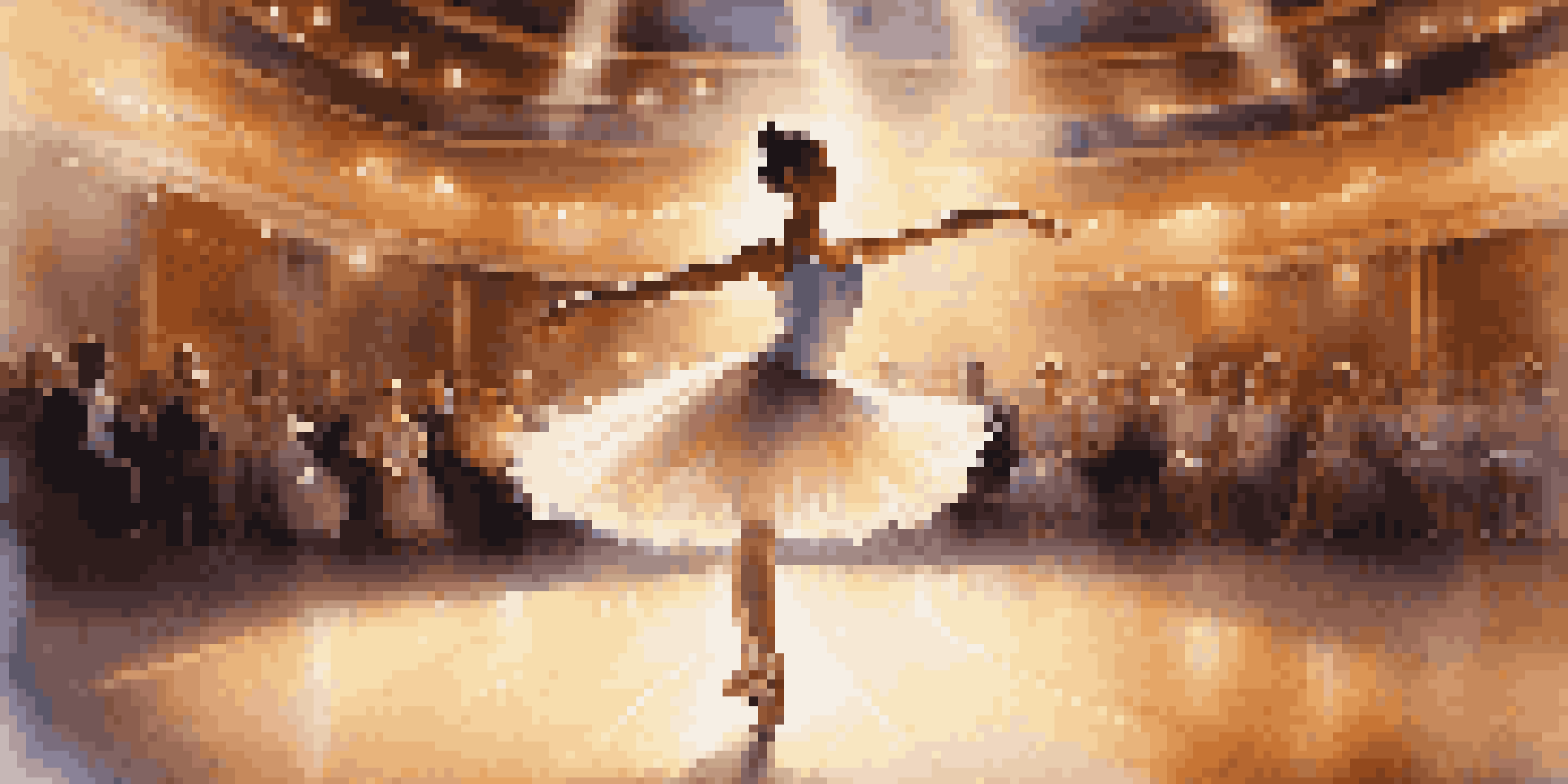The Effect of Diet on Dance Techniques and Skills

Understanding the Connection Between Diet and Dance
Dance is not just about movement; it’s an intricate blend of technique, artistry, and physicality. One crucial yet often overlooked aspect is diet, which can significantly influence a dancer's performance. Just as a car needs the right fuel to run efficiently, dancers require proper nutrition to optimize their skills and endurance.
You are what you eat. So, if you want to be a dancer, you should eat like one.
A well-balanced diet provides dancers with the energy needed for rigorous practice and performances. This energy fuels their muscles, enhances flexibility, and helps sustain stamina throughout long rehearsals. By understanding what foods can support these needs, dancers can elevate their craft to new heights.
Moreover, the right nutrition can aid in recovery, allowing dancers to bounce back quicker after intense sessions. By making informed dietary choices, they can enhance their overall well-being, ensuring they stay in top shape both physically and mentally.
The Role of Macronutrients in Dance Performance
Macronutrients—carbohydrates, proteins, and fats—play distinct roles in a dancer’s diet. Carbohydrates serve as the primary energy source, especially crucial for those engaging in high-intensity dance styles. Think of them as the gasoline that keeps the engine running, fueling movements from pliés to pirouettes.

Proteins, on the other hand, are essential for muscle repair and growth. After a long day of dancing, incorporating protein-rich foods like chicken, beans, or yogurt can help dancers recover and build stronger muscles. This recovery is vital for maintaining technique and preventing injuries.
Diet Fuels Dance Performance
A well-balanced diet provides the necessary energy and stamina for dancers to excel in their practice and performances.
Finally, healthy fats support overall health and energy levels, particularly during long rehearsals. Incorporating sources like avocados or nuts can provide sustained energy without the crash that comes from sugary snacks, helping dancers maintain focus and precision.
Hydration: The Unsung Hero of Dance Nutrition
While food often takes center stage in discussions about diet, hydration is equally crucial for dancers. Water plays a vital role in maintaining energy levels and preventing fatigue. Imagine trying to perform intricate steps on a hot day without proper hydration—it's no wonder that many dancers feel sluggish or unfocused when they neglect their fluid intake.
Nutrition is not just about eating. It’s about learning to live.
Staying hydrated supports muscle function, which is essential for executing complex movements with grace. A dehydrated dancer may experience cramps, reduced flexibility, and decreased performance. To combat this, dancers should aim to drink water before, during, and after practice to keep their bodies functioning optimally.
Additionally, beverages with electrolytes can be beneficial, especially after intense workouts. By prioritizing hydration, dancers can ensure they are performing at their best, both in technique and in artistry.
Timing Your Meals for Peak Performance
Meal timing is an often-overlooked aspect of a dancer's diet. Consuming the right foods at the right times can significantly enhance performance. Ideally, dancers should focus on eating a balanced meal about 2-3 hours before a rehearsal or performance to ensure they have ample energy.
A pre-dance meal that combines carbohydrates and proteins can provide sustained energy and help prevent hunger pangs during practice. For example, a bowl of oatmeal topped with fruits and nuts can be an excellent choice that fuels both body and mind.
Hydration is Crucial for Dancers
Proper hydration supports muscle function and energy levels, preventing fatigue and enhancing performance.
Post-performance meals are just as important, as they help in recovery. Eating a mix of proteins and carbohydrates within 30 minutes after dancing can replenish energy and repair muscles, setting the stage for the next practice.
The Impact of Specific Diets on Dance Techniques
Many dancers explore various dietary approaches, such as vegetarianism, veganism, or gluten-free diets. While these can be healthy choices, they must be carefully planned to ensure they meet nutritional needs. For instance, a vegetarian dancer may need to seek alternative protein sources to maintain muscle health and energy.
Embracing a diet rich in whole foods, such as fruits, vegetables, whole grains, and lean proteins, can support optimal performance regardless of dietary preference. It's crucial for dancers to educate themselves on how to balance their meals to ensure they are not missing out on essential nutrients.
Additionally, consulting with a nutritionist can provide personalized guidance, helping dancers find the best dietary approach to enhance their performance while still enjoying what they eat.
Mindful Eating: Enhancing Focus and Technique
Mindful eating is another aspect that can improve a dancer's performance. This approach encourages individuals to pay attention to their food choices, portion sizes, and the overall eating experience. By being more conscious of what they consume, dancers can make better choices that directly impact their energy levels and focus.
Practicing mindful eating can also help reduce anxiety around food, allowing dancers to view meals as a source of nourishment rather than a source of stress. This shift in mindset can lead to improved concentration during practice and performances.
Mindful Eating Enhances Focus
Practicing mindful eating helps dancers make better food choices, reducing anxiety and improving concentration during performances.
Furthermore, fostering a healthy relationship with food can inspire dancers to explore new ingredients and recipes, keeping their diet exciting and diverse. This excitement can translate into their dance, enhancing creativity and expression.
Listening to Your Body: The Key to Optimal Nutrition
Every dancer's body is unique, and understanding individual needs is vital for optimal nutrition. Listening to one's body can help determine what foods provide the best fuel and how to adjust intake based on energy demands. This intuitive approach can empower dancers to take charge of their health and performance.
For instance, some dancers may find that they perform better with a higher carbohydrate intake, while others might thrive on a more balanced approach. Keeping a food diary can help track what works best, allowing for personalized adjustments.

Ultimately, being in tune with one's body can lead to improved techniques and skills, as dancers learn to recognize how different foods affect their performance. This awareness fosters a deeper connection between mind and body, which is essential in the art of dance.